Srikanth Raj Chetupalli
Training Strategies for Modality Dropout Resilient Multi-Modal Target Speaker Extraction
Jul 09, 2025Abstract:The primary goal of multi-modal TSE (MTSE) is to extract a target speaker from a speech mixture using complementary information from different modalities, such as audio enrolment and visual feeds corresponding to the target speaker. MTSE systems are expected to perform well even when one of the modalities is unavailable. In practice, the systems often suffer from modality dominance, where one of the modalities outweighs the others, thereby limiting robustness. Our study investigates training strategies and the effect of architectural choices, particularly the normalization layers, in yielding a robust MTSE system in both non-causal and causal configurations. In particular, we propose the use of modality dropout training (MDT) as a superior strategy to standard and multi-task training (MTT) strategies. Experiments conducted on two-speaker mixtures from the LRS3 dataset show the MDT strategy to be effective irrespective of the employed normalization layer. In contrast, the models trained with the standard and MTT strategies are susceptible to modality dominance, and their performance depends on the chosen normalization layer. Additionally, we demonstrate that the system trained with MDT strategy is robust to using extracted speech as the enrollment signal, highlighting its potential applicability in scenarios where the target speaker is not enrolled.
Dynamic Slimmable Networks for Efficient Speech Separation
Jul 08, 2025Abstract:Recent progress in speech separation has been largely driven by advances in deep neural networks, yet their high computational and memory requirements hinder deployment on resource-constrained devices. A significant inefficiency in conventional systems arises from using static network architectures that maintain constant computational complexity across all input segments, regardless of their characteristics. This approach is sub-optimal for simpler segments that do not require intensive processing, such as silence or non-overlapping speech. To address this limitation, we propose a dynamic slimmable network (DSN) for speech separation that adaptively adjusts its computational complexity based on the input signal. The DSN combines a slimmable network, which can operate at different network widths, with a lightweight gating module that dynamically determines the required width by analyzing the local input characteristics. To balance performance and efficiency, we introduce a signal-dependent complexity loss that penalizes unnecessary computation based on segmental reconstruction error. Experiments on clean and noisy two-speaker mixtures from the WSJ0-2mix and WHAM! datasets show that the DSN achieves a better performance-efficiency trade-off than individually trained static networks of different sizes.
Low-Complexity Neural Wind Noise Reduction for Audio Recordings
Jul 02, 2025Abstract:Wind noise significantly degrades the quality of outdoor audio recordings, yet remains difficult to suppress in real-time on resource-constrained devices. In this work, we propose a low-complexity single-channel deep neural network that leverages the spectral characteristics of wind noise. Experimental results show that our method achieves performance comparable to the state-of-the-art low-complexity ULCNet model. The proposed model, with only 249K parameters and roughly 73 MHz of computational power, is suitable for embedded and mobile audio applications.
Coswara: A respiratory sounds and symptoms dataset for remote screening of SARS-CoV-2 infection
May 22, 2023Abstract:This paper presents the Coswara dataset, a dataset containing diverse set of respiratory sounds and rich meta-data, recorded between April-2020 and February-2022 from 2635 individuals (1819 SARS-CoV-2 negative, 674 positive, and 142 recovered subjects). The respiratory sounds contained nine sound categories associated with variants of breathing, cough and speech. The rich metadata contained demographic information associated with age, gender and geographic location, as well as the health information relating to the symptoms, pre-existing respiratory ailments, comorbidity and SARS-CoV-2 test status. Our study is the first of its kind to manually annotate the audio quality of the entire dataset (amounting to 65~hours) through manual listening. The paper summarizes the data collection procedure, demographic, symptoms and audio data information. A COVID-19 classifier based on bi-directional long short-term (BLSTM) architecture, is trained and evaluated on the different population sub-groups contained in the dataset to understand the bias/fairness of the model. This enabled the analysis of the impact of gender, geographic location, date of recording, and language proficiency on the COVID-19 detection performance.
Beamformer-Guided Target Speaker Extraction
Mar 15, 2023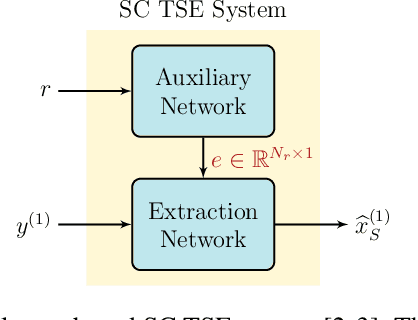
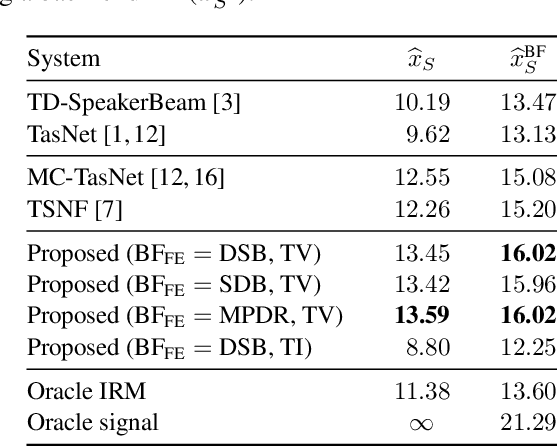
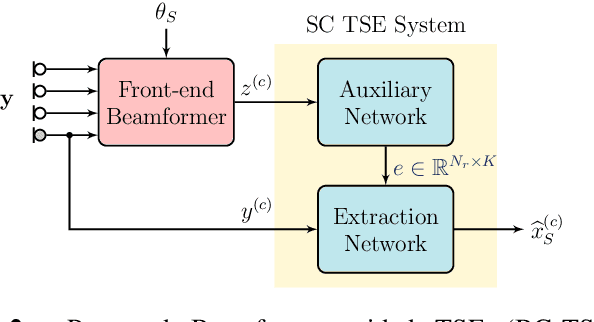
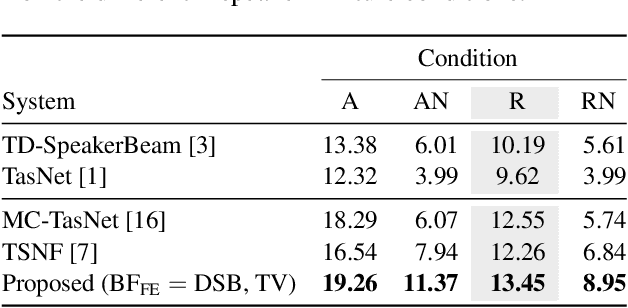
Abstract:We propose a Beamformer-guided Target Speaker Extraction (BG-TSE) method to extract a target speaker's voice from a multi-channel recording informed by the direction of arrival of the target. The proposed method employs a front-end beamformer steered towards the target speaker to provide an auxiliary signal to a single-channel TSE system. By allowing for time-varying embeddings in the single-channel TSE block, the proposed method fully exploits the correspondence between the front-end beamformer output and the target speech in the microphone signal. Experimental evaluation on simulated multi-channel 2-speaker mixtures, in both anechoic and reverberant conditions, demonstrates the advantage of the proposed method compared to recent single-channel and multi-channel baselines.
Multi-Microphone Speaker Separation by Spatial Regions
Mar 13, 2023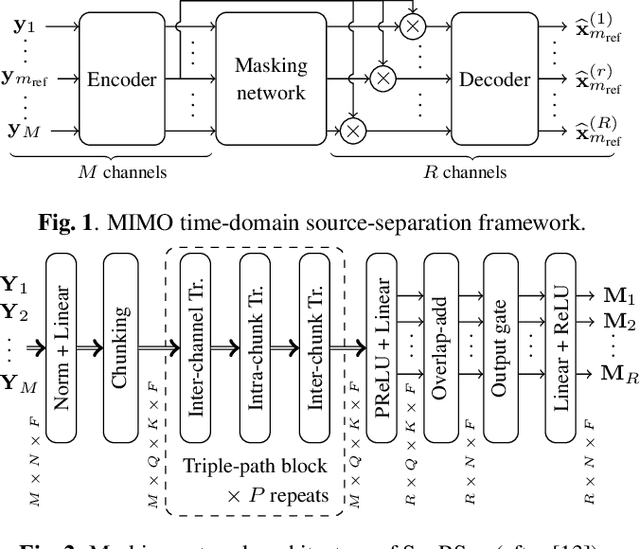


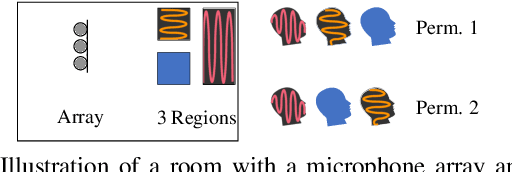
Abstract:We consider the task of region-based source separation of reverberant multi-microphone recordings. We assume pre-defined spatial regions with a single active source per region. The objective is to estimate the signals from the individual spatial regions as captured by a reference microphone while retaining a correspondence between signals and spatial regions. We propose a data-driven approach using a modified version of a state-of-the-art network, where different layers model spatial and spectro-temporal information. The network is trained to enforce a fixed mapping of regions to network outputs. Using speech from LibriMix, we construct a data set specifically designed to contain the region information. Additionally, we train the network with permutation invariant training. We show that both training methods result in a fixed mapping of regions to network outputs, achieve comparable performance, and that the networks exploit spatial information. The proposed network outperforms a baseline network by 1.5 dB in scale-invariant signal-to-distortion ratio.
Analyzing the impact of SARS-CoV-2 variants on respiratory sound signals
Jun 24, 2022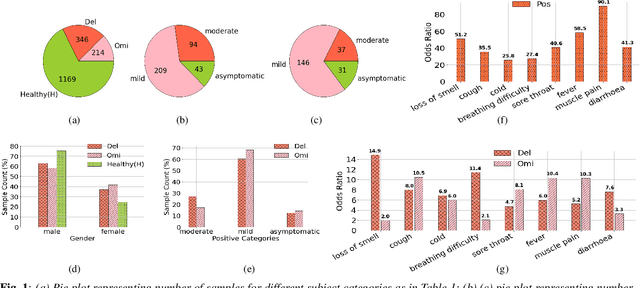
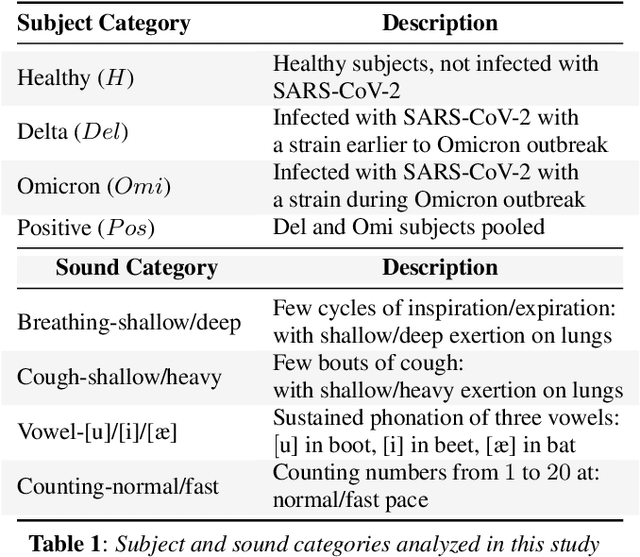
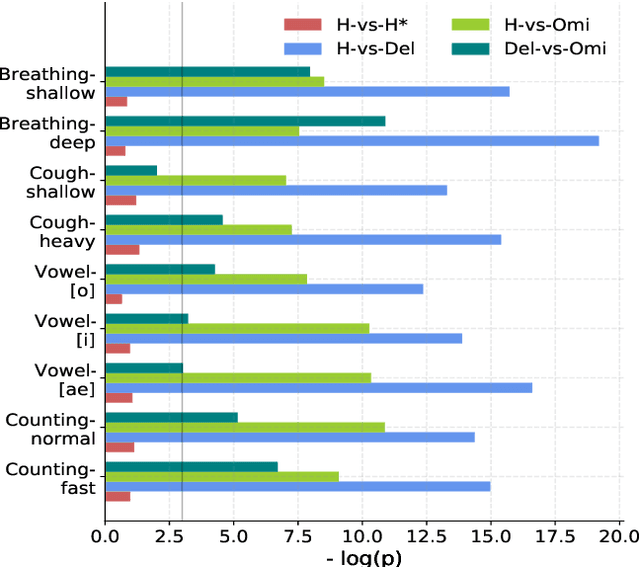
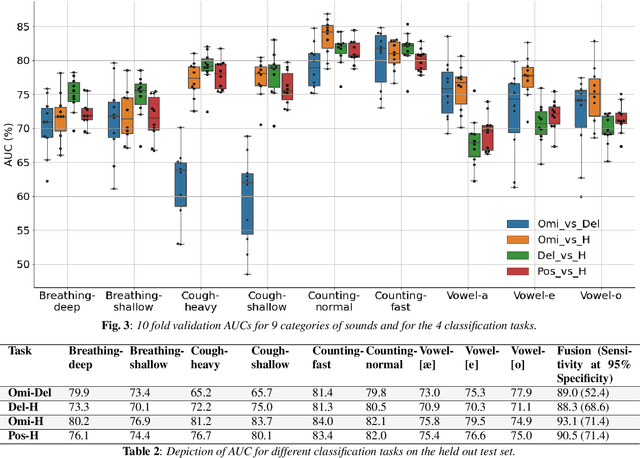
Abstract:The COVID-19 outbreak resulted in multiple waves of infections that have been associated with different SARS-CoV-2 variants. Studies have reported differential impact of the variants on respiratory health of patients. We explore whether acoustic signals, collected from COVID-19 subjects, show computationally distinguishable acoustic patterns suggesting a possibility to predict the underlying virus variant. We analyze the Coswara dataset which is collected from three subject pools, namely, i) healthy, ii) COVID-19 subjects recorded during the delta variant dominant period, and iii) data from COVID-19 subjects recorded during the omicron surge. Our findings suggest that multiple sound categories, such as cough, breathing, and speech, indicate significant acoustic feature differences when comparing COVID-19 subjects with omicron and delta variants. The classification areas-under-the-curve are significantly above chance for differentiating subjects infected by omicron from those infected by delta. Using a score fusion from multiple sound categories, we obtained an area-under-the-curve of 89% and 52.4% sensitivity at 95% specificity. Additionally, a hierarchical three class approach was used to classify the acoustic data into healthy and COVID-19 positive, and further COVID-19 subjects into delta and omicron variants providing high level of 3-class classification accuracy. These results suggest new ways for designing sound based COVID-19 diagnosis approaches.
AmbiSep: Ambisonic-to-Ambisonic Reverberant Speech Separation Using Transformer Networks
Jun 13, 2022

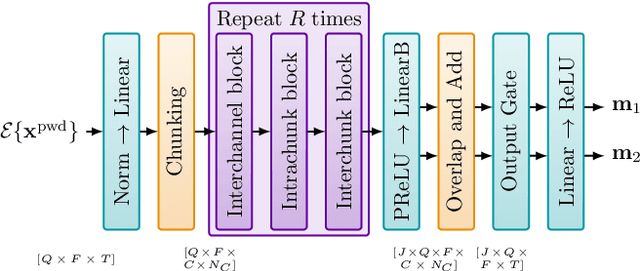
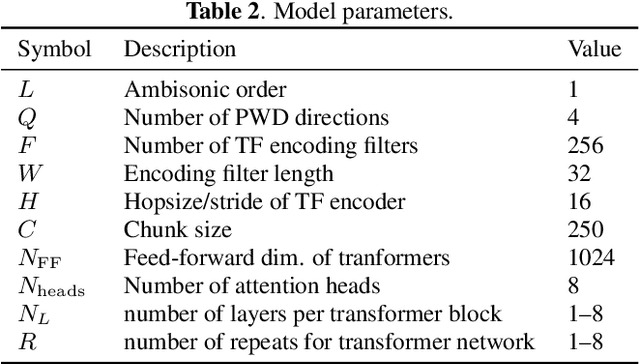
Abstract:Consider a multichannel Ambisonic recording containing a mixture of several reverberant speech signals. Retreiving the reverberant Ambisonic signals corresponding to the individual speech sources blindly from the mixture is a challenging task as it requires to estimate multiple signal channels for each source. In this work, we propose AmbiSep, a deep neural network-based plane-wave domain masking approach to solve this task. The masking network uses learned feature representations and transformers in a triple-path processing configuration. We train and evaluate the proposed network architecture on a spatialized WSJ0-2mix dataset, and show that the method achieves a multichannel scale-invariant signal-to-distortion ratio improvement of 17.7 dB on the blind test set, while preserving the spatial characteristics of the separated sounds.
Coswara: A website application enabling COVID-19 screening by analysing respiratory sound samples and health symptoms
Jun 09, 2022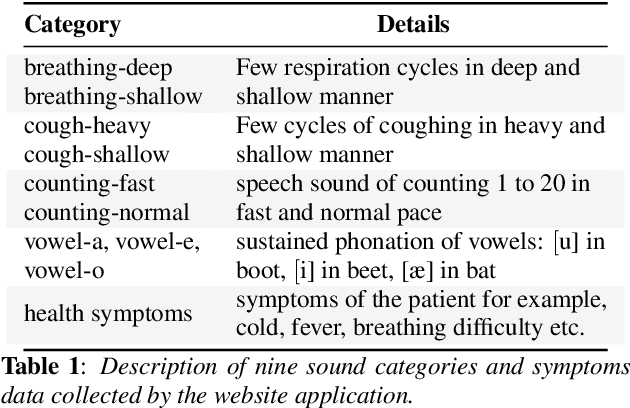
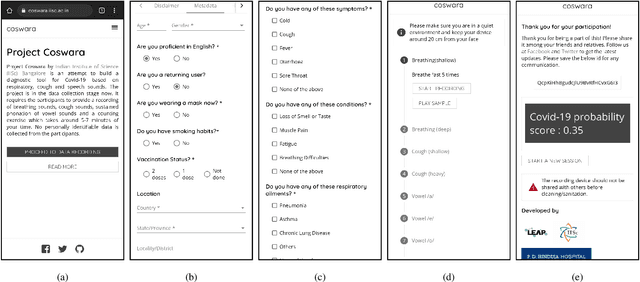

Abstract:The COVID-19 pandemic has accelerated research on design of alternative, quick and effective COVID-19 diagnosis approaches. In this paper, we describe the Coswara tool, a website application designed to enable COVID-19 detection by analysing respiratory sound samples and health symptoms. A user using this service can log into a website using any device connected to the internet, provide there current health symptom information and record few sound sampled corresponding to breathing, cough, and speech. Within a minute of analysis of this information on a cloud server the website tool will output a COVID-19 probability score to the user. As the COVID-19 pandemic continues to demand massive and scalable population level testing, we hypothesize that the proposed tool provides a potential solution towards this.
The Second DiCOVA Challenge: Dataset and performance analysis for COVID-19 diagnosis using acoustics
Oct 11, 2021
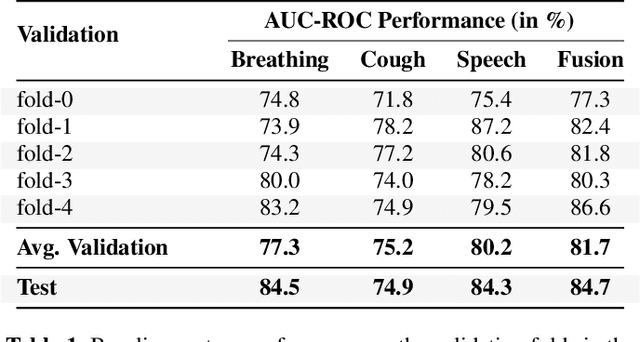
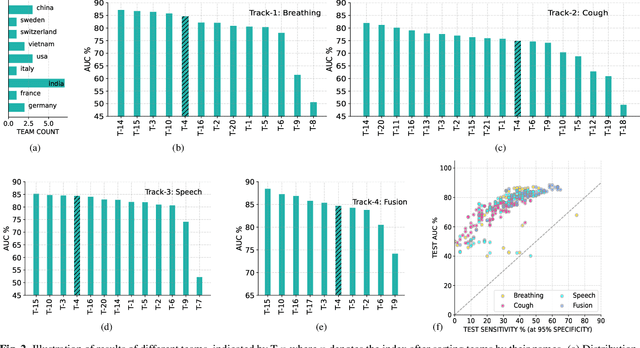
Abstract:The Second Diagnosis of COVID-19 using Acoustics (DiCOVA) Challenge aimed at accelerating the research in acoustics based detection of COVID-19, a topic at the intersection of acoustics, signal processing, machine learning, and healthcare. This paper presents the details of the challenge, which was an open call for researchers to analyze a dataset of audio recordings consisting of breathing, cough and speech signals. This data was collected from individuals with and without COVID-19 infection, and the task in the challenge was a two-class classification. The development set audio recordings were collected from 965 (172 COVID-19 positive) individuals, while the evaluation set contained data from 471 individuals (71 COVID-19 positive). The challenge featured four tracks, one associated with each sound category of cough, speech and breathing, and a fourth fusion track. A baseline system was also released to benchmark the participants. In this paper, we present an overview of the challenge, the rationale for the data collection and the baseline system. Further, a performance analysis for the systems submitted by the $16$ participating teams in the leaderboard is also presented.
 Add to Chrome
Add to Chrome Add to Firefox
Add to Firefox Add to Edge
Add to Edge